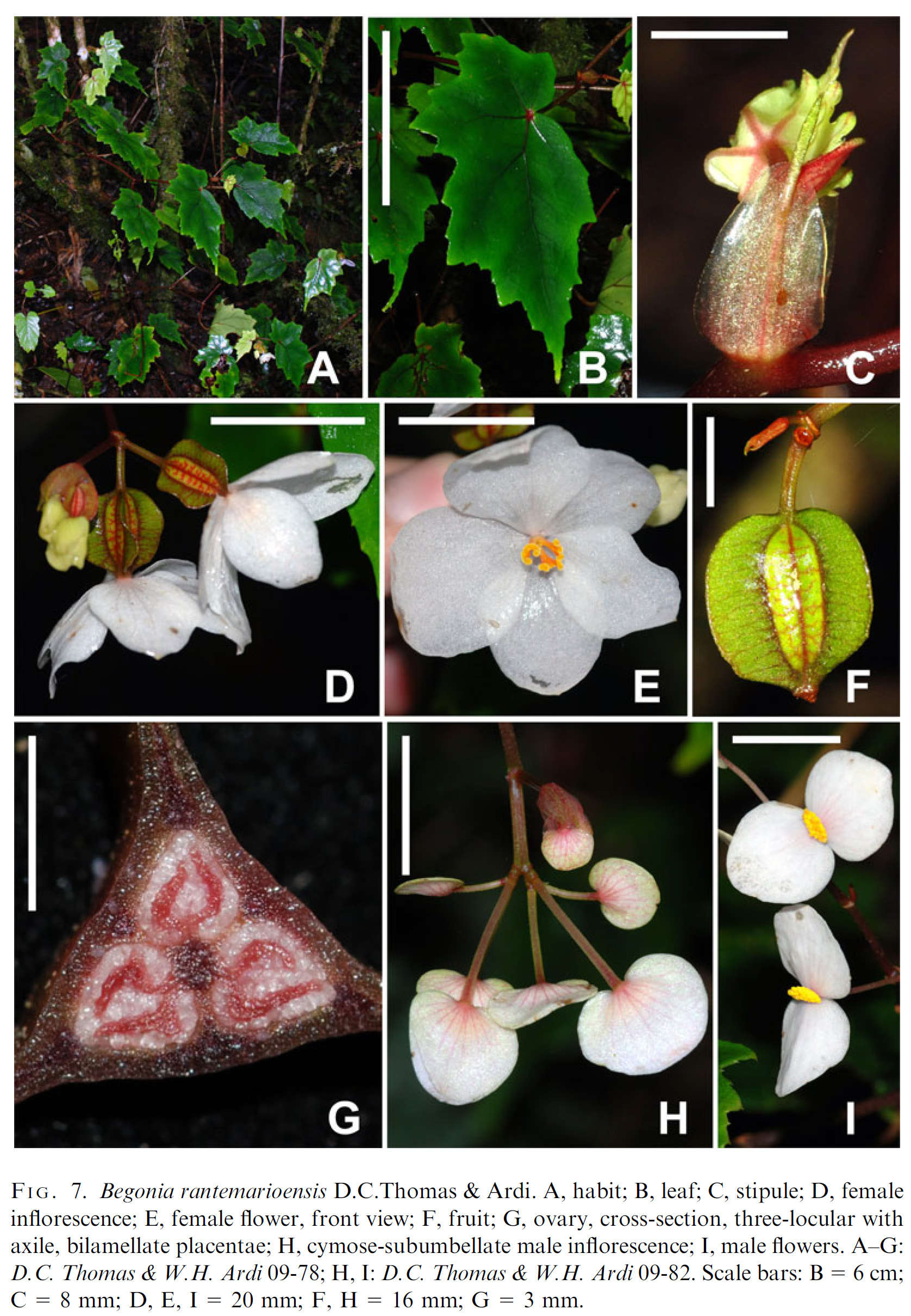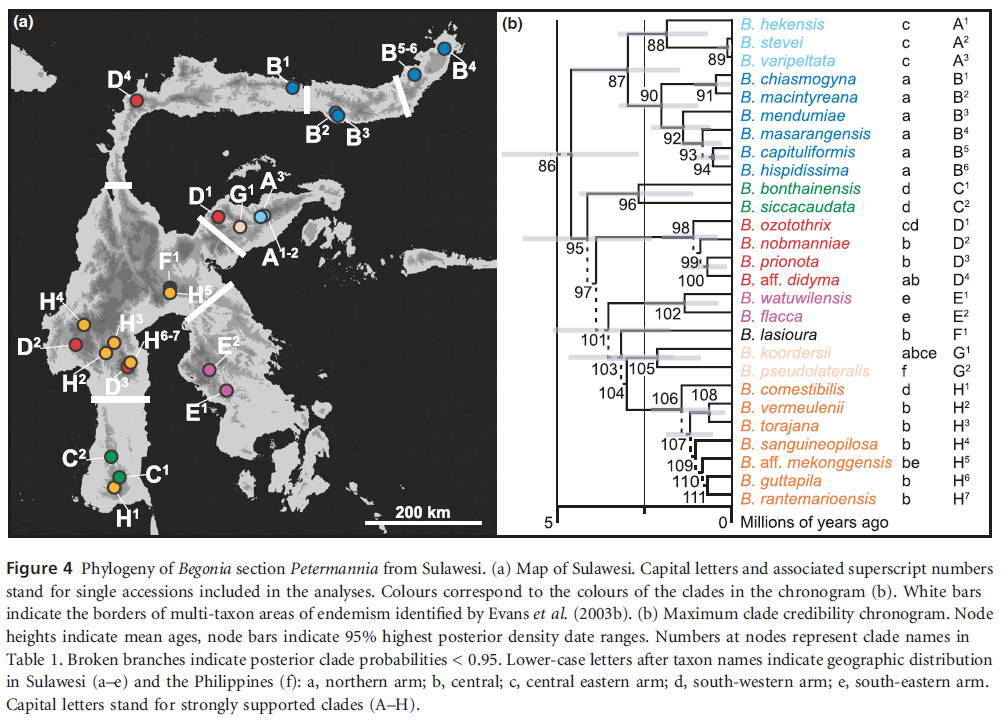Begonia rantemarioensis in Edinburgh J. Bot. 68(2): 240. 2011
Primary tabs

Diagnosis
- Begoniae sanguineopilosae D.C.Thomas & Ardi similis sed a qua foliis majoribus (11-15.7 × 4.5-7.7 cm nec 5.5-12 × 2-5 cm), marginibus foliorum profunde duplicoserratis usque vadose lobatis et indumento in ovariis tepalisque rubello carenti differt. - Type: Indonesia, Sulawesi, Sulawesi Selatan, Gunung Rantemario, primary rainforest on steep slope, 03°24'32.3S, 120°00'24.9E, 1978 m, 24 iv 2009, D.C. Thomas & W.H. Ardi 09-82 (holo E; iso BO, L). (Thomas, D.C., Ardi, W.H. & Hughes, M., Nine new species of Begonia (Begoniaceae) from South and West Sulawesi, Indonesia in Edinburgh Journal of Botany 68(2). 2011)
Description
- Perennial, dioecious? herb, with erect stems, to c.60 cm tall, glabrous except for a sparse indumentum of microscopic, glandular hairs.
Stems branched; internodes c.3-16 cm long, brownish-reddish.
Leaves alternate; usually with basifixed laminas or sometimes some leaves strongly excentrically peltate; stipules caducous, 11-17 × 7-10 mm, elliptic to ovate, with an abaxially prominent midrib that projects up to c.4 mm at the apex; petioles 3-9 cm long, brownish-reddish; lamina 11-15.7 × 4.5-7.7 cm, very asymmetric, ovate to elliptic, leaf margin slightly sinuate close to the petiole (strongly excentrically peltate leaves) or base cordate and lobes not over- lapping (basifixed laminas), apex acuminate, margin biserrate to shallowly lobed (up to c.25% of the lamina width), irregularly scalloped, teeth not bristle-pointed, adaxial surface dark green and abaxial surface pale green, coriaceous, primary veins 4-5, actinodromous, secondary veins craspedodromous.
Inflorescences: female inflorescences 2-flowered, with 1-2 partial inflorescences at subsequent nodes, peduncles c.1 mm long; male inflorescences composed of 2-7 cymose-subumbellate partial inflorescences, each with usually 2 compressed monochasia with 1-3 flowers, peduncles 9-14 mm long.
Male flowers: pedicels 18-32 mm long; tepals 2, white with pale pinkish veins to pink, 14-20 × 16-20 mm, broadly ovate to suborbicular, base cordate, apex rounded; androecium of c.48-57 stamens, yellow, filaments up to c.2.5 mm long, slightly fused at the base, anthers c.1-1.5 mm long, obovate to oblong, dehiscing through unilaterally positioned slits that are > ½ as long as the anther.
Female flowers: pedicels 6-8 mm long; tepals 5, white, subequal, 21-26 × 15-20 mm, elliptic to suborbicular; ovary ellipsoid, locules 3, placentation axile, placentae bilamellate, wings 3, triangular or crescent-shaped, subequal, base rounded, apex rounded or truncate, widest at the apex or the middle, style basally shortly fused, 3-branched, each stylodium bifurcate in the stigmatic region, stigmatic surface a spirally twisted papillose band, yellow.
Fruiting pedicels up to c.8 mm long. Fruits slightly fleshy, ellipsoid, 13-16 × 7-8 mm (excluding the wings), indehiscent?, wing shape as for ovary, 7-8 mm wide at the widest point (in the middle part or at the apex of the ovary); seeds ellipsoidal, c.0.3-0.4 mm long, collar cells c.1/2-2/3 of the length of the seed. (Thomas, D.C., Ardi, W.H. & Hughes, M., Nine new species of Begonia (Begoniaceae) from South and West Sulawesi, Indonesia in Edinburgh Journal of Botany 68(2). 2011)
Habitat
- This is a rainforest floor species, growing on steep slopes between c.1500 and 2000 m above sea level.
Conservation
- Proposed IUCN conservation category. Least Concern (LC). The distribution of Begonia rantemarioensis lies just outside the western border of the Pegunungan Latimojong Protection Forest (IUCN category VI). Although Begonia rantemarioensis is relatively rare in the area, several subpopulations were observed in habitats located in primary rainforest not yet encroached by human habitation, agriculture or commercial logging activities. Therefore, a ?Least Concern? status seems to be indicated. (Thomas, D.C., Ardi, W.H. & Hughes, M., Nine new species of Begonia (Begoniaceae) from South and West Sulawesi, Indonesia in Edinburgh Journal of Botany 68(2). 2011)
Distribution
Asia-Tropical: Sulawesi (Sulawesi endemic)
See Images for a distribution map, and specimen tab for map of point distribution data of georeferenced specimens.
Endemic to Indonesia, Sulawesi, South Sulawesi.
Etymology
- The specific epithet refers to the collection locality of the type material, Gunung Rantemario (Latin, -ensis - originating from).
Notes
- Dioecy is a rare sexual system in the predominantly monoecious genus Begonia, and in Asian Begonia it has only been reported from a few species placed in Begonia section Sphenanthera (Hassk.) Warb. (Tebbitt, 1997; Tebbitt et al., 2006; Gu et al., 2007), one Sulawesi species in Begonia section Petermannia (B. mekonggensis Girm. & Wiriad.; Girmansyah et al., 2009), and the Himalayan B. dioica Buch.-Ham. ex D.Don, which is currently placed in the polyphyletic Begonia section Diploclinium. The determination of dioecy in Begonia can be problematic, as many species show well-developed dichogamy. This can easily result in erroneous descriptions of dioecy in the genus (Badcock, 1998). However, several observations indicate that Begonia rantemarioensis belongs to a group of closely related Sulawesi endemics which exhibit real dioecy. Firstly, the suggestions of dioecy are based on field observations. Several populations of Begonia rantemarioensis were observed in the field and several individuals, often growing closely together, showed various ontogenetic stages of only female or only male flowers, respectively. Secondly, phylogenies based on chloroplast DNA data indicate that Begonia guttapila and another undescribed species (D.C. Thomas &W.H. Ardi 08-84 [E]) are closely related to B. rantemarioensis (Thomas, 2010). Material of Begonia guttapila and the closely related undescribed species has been cultivated at Bali Botanic Garden for several years, and different individuals consistently develop only male or only female flowers, respectively (Hartutiningsih, pers. comm.). Begonia rantemarioensis is in cultivation at Bali Botanic Garden and further observations will show whether dioecy can be confirmed in this and closely related species. The putative dioecy, the succulent, coriaceous leaves and the semi-fleshy and maybe indehiscent fruits indicate a close relationship to Begonia sanguineopilosa and B. torajana, which are described below. Begonia imperfecta Irmsch., B. sarasinorum Irmsch. and B. sphenocarpa Irmsch., which have been described from Central and South Sulawesi, are only known from the unisexual type material, and may belong to this group as well. However, further collections and field observations of these poorly known species are needed to confirm this. (Thomas, D.C., Ardi, W.H. & Hughes, M., Nine new species of Begonia (Begoniaceae) from South and West Sulawesi, Indonesia in Edinburgh Journal of Botany 68(2). 2011)
Molecular Systematics
- see Thomas et al., 2012 (Thomas, D.C., Hughes, M., Phutthai, T., Ardi, W.H., Rajbhandary, S., Rubite, R., Twyford, A.D. & Richardson, J.E. 2012: West to east dispersal and subsequent rapid diversification of the mega-diverse genus Begonia (Begoniaceae) in the Malesian archipelago. – Journal of Biogeography 39: 98-113)
- GenBank
 |


